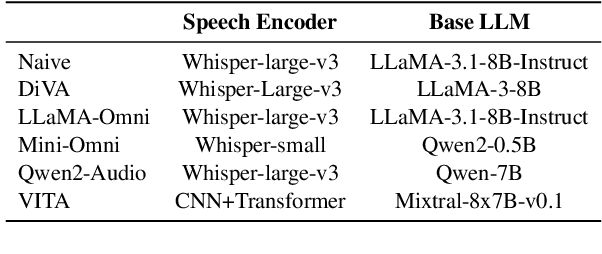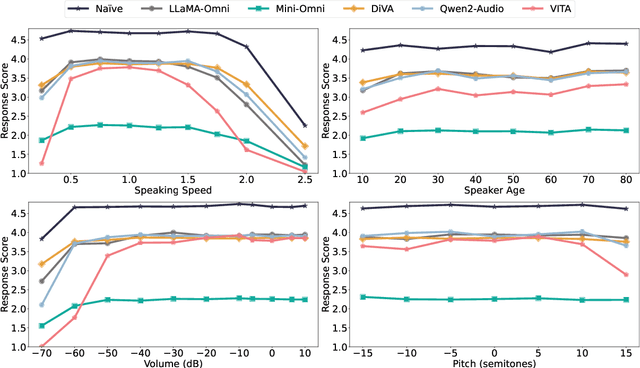Yiming Chen
Clink! Chop! Thud! -- Learning Object Sounds from Real-World Interactions
Oct 02, 2025Abstract:Can a model distinguish between the sound of a spoon hitting a hardwood floor versus a carpeted one? Everyday object interactions produce sounds unique to the objects involved. We introduce the sounding object detection task to evaluate a model's ability to link these sounds to the objects directly involved. Inspired by human perception, our multimodal object-aware framework learns from in-the-wild egocentric videos. To encourage an object-centric approach, we first develop an automatic pipeline to compute segmentation masks of the objects involved to guide the model's focus during training towards the most informative regions of the interaction. A slot attention visual encoder is used to further enforce an object prior. We demonstrate state of the art performance on our new task along with existing multimodal action understanding tasks.
Advancing Complex Wide-Area Scene Understanding with Hierarchical Coresets Selection
Jul 17, 2025Abstract:Scene understanding is one of the core tasks in computer vision, aiming to extract semantic information from images to identify objects, scene categories, and their interrelationships. Although advancements in Vision-Language Models (VLMs) have driven progress in this field, existing VLMs still face challenges in adaptation to unseen complex wide-area scenes. To address the challenges, this paper proposes a Hierarchical Coresets Selection (HCS) mechanism to advance the adaptation of VLMs in complex wide-area scene understanding. It progressively refines the selected regions based on the proposed theoretically guaranteed importance function, which considers utility, representativeness, robustness, and synergy. Without requiring additional fine-tuning, HCS enables VLMs to achieve rapid understandings of unseen scenes at any scale using minimal interpretable regions while mitigating insufficient feature density. HCS is a plug-and-play method that is compatible with any VLM. Experiments demonstrate that HCS achieves superior performance and universality in various tasks.
HARDMath2: A Benchmark for Applied Mathematics Built by Students as Part of a Graduate Class
May 17, 2025Abstract:Large language models (LLMs) have shown remarkable progress in mathematical problem-solving, but evaluation has largely focused on problems that have exact analytical solutions or involve formal proofs, often overlooking approximation-based problems ubiquitous in applied science and engineering. To fill this gap, we build on prior work and present HARDMath2, a dataset of 211 original problems covering the core topics in an introductory graduate applied math class, including boundary-layer analysis, WKB methods, asymptotic solutions of nonlinear partial differential equations, and the asymptotics of oscillatory integrals. This dataset was designed and verified by the students and instructors of a core graduate applied mathematics course at Harvard. We build the dataset through a novel collaborative environment that challenges students to write and refine difficult problems consistent with the class syllabus, peer-validate solutions, test different models, and automatically check LLM-generated solutions against their own answers and numerical ground truths. Evaluation results show that leading frontier models still struggle with many of the problems in the dataset, highlighting a gap in the mathematical reasoning skills of current LLMs. Importantly, students identified strategies to create increasingly difficult problems by interacting with the models and exploiting common failure modes. This back-and-forth with the models not only resulted in a richer and more challenging benchmark but also led to qualitative improvements in the students' understanding of the course material, which is increasingly important as we enter an age where state-of-the-art language models can solve many challenging problems across a wide domain of fields.
VicaSplat: A Single Run is All You Need for 3D Gaussian Splatting and Camera Estimation from Unposed Video Frames
Mar 13, 2025Abstract:We present VicaSplat, a novel framework for joint 3D Gaussians reconstruction and camera pose estimation from a sequence of unposed video frames, which is a critical yet underexplored task in real-world 3D applications. The core of our method lies in a novel transformer-based network architecture. In particular, our model starts with an image encoder that maps each image to a list of visual tokens. All visual tokens are concatenated with additional inserted learnable camera tokens. The obtained tokens then fully communicate with each other within a tailored transformer decoder. The camera tokens causally aggregate features from visual tokens of different views, and further modulate them frame-wisely to inject view-dependent features. 3D Gaussian splats and camera pose parameters can then be estimated via different prediction heads. Experiments show that VicaSplat surpasses baseline methods for multi-view inputs, and achieves comparable performance to prior two-view approaches. Remarkably, VicaSplat also demonstrates exceptional cross-dataset generalization capability on the ScanNet benchmark, achieving superior performance without any fine-tuning. Project page: https://lizhiqi49.github.io/VicaSplat.
Recent Advances in Large Langauge Model Benchmarks against Data Contamination: From Static to Dynamic Evaluation
Feb 23, 2025Abstract:Data contamination has received increasing attention in the era of large language models (LLMs) due to their reliance on vast Internet-derived training corpora. To mitigate the risk of potential data contamination, LLM benchmarking has undergone a transformation from static to dynamic benchmarking. In this work, we conduct an in-depth analysis of existing static to dynamic benchmarking methods aimed at reducing data contamination risks. We first examine methods that enhance static benchmarks and identify their inherent limitations. We then highlight a critical gap-the lack of standardized criteria for evaluating dynamic benchmarks. Based on this observation, we propose a series of optimal design principles for dynamic benchmarking and analyze the limitations of existing dynamic benchmarks. This survey provides a concise yet comprehensive overview of recent advancements in data contamination research, offering valuable insights and a clear guide for future research efforts. We maintain a GitHub repository to continuously collect both static and dynamic benchmarking methods for LLMs. The repository can be found at this link.
Human-Like Robot Impedance Regulation Skill Learning from Human-Human Demonstrations
Feb 19, 2025Abstract:Humans are experts in collaborating with others physically by regulating compliance behaviors based on the perception of their partner states and the task requirements. Enabling robots to develop proficiency in human collaboration skills can facilitate more efficient human-robot collaboration (HRC). This paper introduces an innovative impedance regulation skill learning framework for achieving HRC in multiple physical collaborative tasks. The framework is designed to adjust the robot compliance to the human partner states while adhering to reference trajectories provided by human-human demonstrations. Specifically, electromyography (EMG) signals from human muscles are collected and analyzed to extract limb impedance, representing compliance behaviors during demonstrations. Human endpoint motions are captured and represented using a probabilistic learning method to create reference trajectories and corresponding impedance profiles. Meanwhile, an LSTMbased module is implemented to develop task-oriented impedance regulation policies by mapping the muscle synergistic contributions between two demonstrators. Finally, we propose a wholebody impedance controller for a human-like robot, coordinating joint outputs to achieve the desired impedance and reference trajectory during task execution. Experimental validation was conducted through a collaborative transportation task and two interactive Tai Chi pushing hands tasks, demonstrating superior performance from the perspective of interactive forces compared to a constant impedance control method.
A Memory Efficient Randomized Subspace Optimization Method for Training Large Language Models
Feb 11, 2025Abstract:The memory challenges associated with training Large Language Models (LLMs) have become a critical concern, particularly when using the Adam optimizer. To address this issue, numerous memory-efficient techniques have been proposed, with GaLore standing out as a notable example designed to reduce the memory footprint of optimizer states. However, these approaches do not alleviate the memory burden imposed by activations, rendering them unsuitable for scenarios involving long context sequences or large mini-batches. Moreover, their convergence properties are still not well-understood in the literature. In this work, we introduce a Randomized Subspace Optimization framework for pre-training and fine-tuning LLMs. Our approach decomposes the high-dimensional training problem into a series of lower-dimensional subproblems. At each iteration, a random subspace is selected, and the parameters within that subspace are optimized. This structured reduction in dimensionality allows our method to simultaneously reduce memory usage for both activations and optimizer states. We establish comprehensive convergence guarantees and derive rates for various scenarios, accommodating different optimization strategies to solve the subproblems. Extensive experiments validate the superior memory and communication efficiency of our method, achieving performance comparable to GaLore and Adam.
PAL: Prompting Analytic Learning with Missing Modality for Multi-Modal Class-Incremental Learning
Jan 16, 2025Abstract:Multi-modal class-incremental learning (MMCIL) seeks to leverage multi-modal data, such as audio-visual and image-text pairs, thereby enabling models to learn continuously across a sequence of tasks while mitigating forgetting. While existing studies primarily focus on the integration and utilization of multi-modal information for MMCIL, a critical challenge remains: the issue of missing modalities during incremental learning phases. This oversight can exacerbate severe forgetting and significantly impair model performance. To bridge this gap, we propose PAL, a novel exemplar-free framework tailored to MMCIL under missing-modality scenarios. Concretely, we devise modality-specific prompts to compensate for missing information, facilitating the model to maintain a holistic representation of the data. On this foundation, we reformulate the MMCIL problem into a Recursive Least-Squares task, delivering an analytical linear solution. Building upon these, PAL not only alleviates the inherent under-fitting limitation in analytic learning but also preserves the holistic representation of missing-modality data, achieving superior performance with less forgetting across various multi-modal incremental scenarios. Extensive experiments demonstrate that PAL significantly outperforms competitive methods across various datasets, including UPMC-Food101 and N24News, showcasing its robustness towards modality absence and its anti-forgetting ability to maintain high incremental accuracy.
Transferable Adversarial Attacks against ASR
Nov 14, 2024


Abstract:Given the extensive research and real-world applications of automatic speech recognition (ASR), ensuring the robustness of ASR models against minor input perturbations becomes a crucial consideration for maintaining their effectiveness in real-time scenarios. Previous explorations into ASR model robustness have predominantly revolved around evaluating accuracy on white-box settings with full access to ASR models. Nevertheless, full ASR model details are often not available in real-world applications. Therefore, evaluating the robustness of black-box ASR models is essential for a comprehensive understanding of ASR model resilience. In this regard, we thoroughly study the vulnerability of practical black-box attacks in cutting-edge ASR models and propose to employ two advanced time-domain-based transferable attacks alongside our differentiable feature extractor. We also propose a speech-aware gradient optimization approach (SAGO) for ASR, which forces mistranscription with minimal impact on human imperceptibility through voice activity detection rule and a speech-aware gradient-oriented optimizer. Our comprehensive experimental results reveal performance enhancements compared to baseline approaches across five models on two databases.
VoiceBench: Benchmarking LLM-Based Voice Assistants
Oct 22, 2024



Abstract:Building on the success of large language models (LLMs), recent advancements such as GPT-4o have enabled real-time speech interactions through LLM-based voice assistants, offering a significantly improved user experience compared to traditional text-based interactions. However, the absence of benchmarks designed to evaluate these speech interaction capabilities has hindered progress of LLM-based voice assistants development. Current evaluations focus primarily on automatic speech recognition (ASR) or general knowledge evaluation with clean speeches, neglecting the more intricate, real-world scenarios that involve diverse speaker characteristics, environmental and content factors. To address this, we introduce VoiceBench, the first benchmark designed to provide a multi-faceted evaluation of LLM-based voice assistants. VoiceBench also includes both real and synthetic spoken instructions that incorporate the above three key real-world variations. Extensive experiments reveal the limitations of current LLM-based voice assistant models and offer valuable insights for future research and development in this field.
 Add to Chrome
Add to Chrome Add to Firefox
Add to Firefox Add to Edge
Add to Edge